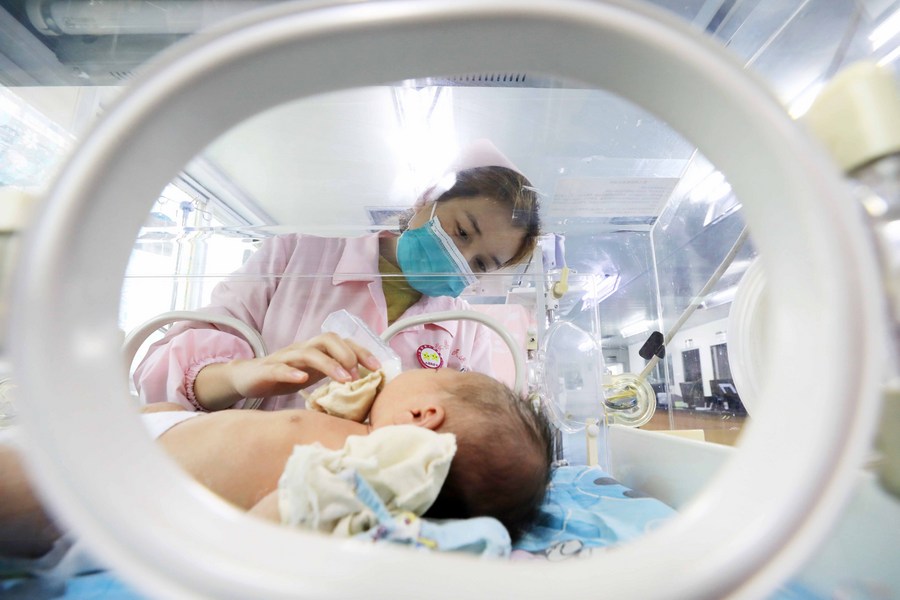
Crowds flock to a street in Tianjin, north China, February 17, 2021. /Xinhua
Crowds flock to a street in Tianjin, north China, February 17, 2021. /Xinhua
Editor's note: Chen Wei is a professor at the Center for Population and Development Studies, Renmin University of China. The article reflects the author's views and not necessarily those of CGTN.
The world's population reached 8 billion in 2022 and will continue to grow until the 2080s, while China's population growth hit negative in 2022. China's future population and demographic structure changes will be more rapid and profound than previously anticipated. According to the United Nations Population Prospects report, the total population of China will still be around 1.4 billion in 2035, only a slight decline. Although population decline will accelerate after 2040, China's population will be about 1.3 billion in 2050, which is still a huge population scale, larger than the total population of developed regions.
Despite a rapidly aging population, the proportion of people aged 65 or above in China will rise from 13 percent today to slightly over 20 percent in 2035 and around 30 percent in 2050, on par with the European average but significantly lower than in Japan and South Korea.
China's demographic transition is one of the fastest in the world, which has made important contributions to China's rapid economic growth over the past four decades. In the first three decades after the establishment of the People's Republic of China in 1949, average life expectancy rose from less than 40 years to more than 60 years, and the fertility rate fell quickly after the early 1970s.
This demographic transformation created an age structure low at both ends and high in the middle, which formed a huge demographic dividend that has contributed to the country's 40 years of economic growth.
With the completion of the demographic transition, the fertility rate remains at a low level, and people entering the labor force continue to decrease, while people who exit the labor force are increasing. China's working-age population began to decline in 2013. Some scholars believe that China's demographic dividend has already come to an end. Current and future demographic changes will bring challenges to China's economic development.
But if we only look at demographic indicators, that is, the proportion of the working-age population and its dependency ratio, China's demographic dividend has not disappeared and could last for another 10 years. By 2035, the working-age population will account for 67-70 percent and the dependency ratio will be still below 50 percent.

A nurse feeds a newborn at the neonatology department of the People's Hospital of Rong'an, south China's Guangxi Zhuang Autonomous Region, January 1, 2021. /Xinhua
A nurse feeds a newborn at the neonatology department of the People's Hospital of Rong'an, south China's Guangxi Zhuang Autonomous Region, January 1, 2021. /Xinhua
But more importantly, the health and education levels of China's population have improved dramatically in the last 20 years. According to China's population census in 2020, the average life expectancy was 77.93 years, and the infant mortality rate had dropped to 5.4 per thousand, already exceeding the average level of middle- and high-income countries. China has also established the world's largest education system as a total of 240 million people received tertiary education.
Further, China is the only country that has all the industrial categories listed in the UN industrial classification. In the next decade, the size of the country's population will remain huge, which will be able to maintain its sound industrial system and provide sufficient room for economic structural transformation. China's growing aging population in good health and education conditions will also increase the consumption of goods and services.
The demographic transition also has a savings effect. In macroeconomic theory, savings equals investment. China's savings rate has always been high, and lower fertility and longer life expectancy will bring more savings for both old-age and human capital investment. Moreover, the next generation will receive better education, which will increase production capacity and labor productivity.
In the condition of a low fertility rate, women will have less time to give birth and raise children with more time spent on education and training, which will raise women's labor force participation rate.
In sum, China's first demographic dividend has not yet faded, but the second demographic dividend is taking shape.
(If you want to contribute and have specific expertise, please contact us at opinions@cgtn.com. Follow @thouse_opinions on Twitter to discover the latest commentaries in the CGTN Opinion Section.)